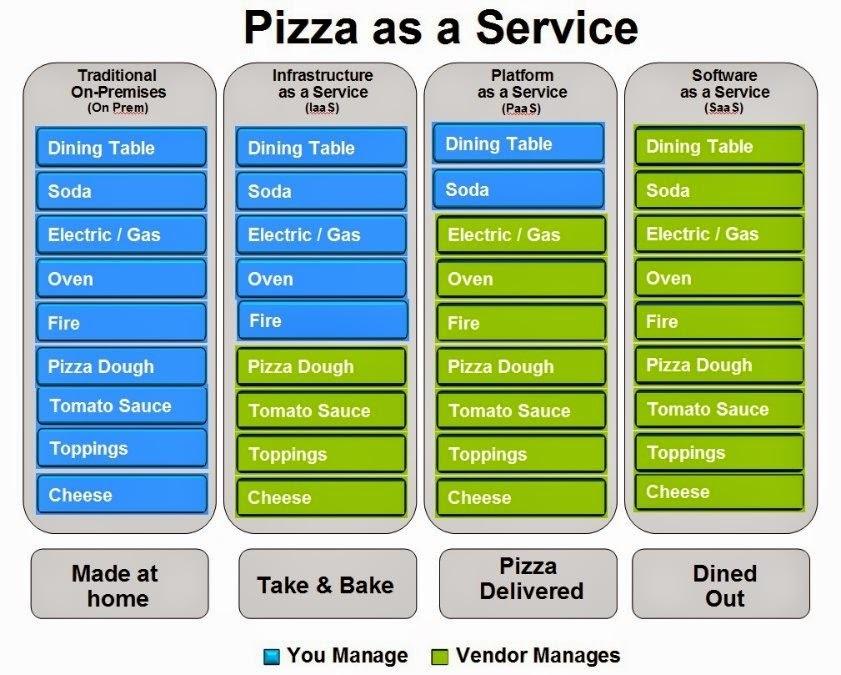We’re hearing the words ‘as a service’ all the time now in the IT industry. ‘Everything as a service’, ‘software as a service’, even ‘Surface as a Service’! What’s annoying is when you keep hearing the term repeatedly and you are still not quite sure what it means.
To be simple, ‘IT as a service’ is where IT services are delivered to you remotely through the Cloud. You generally have little capital expenditure and can scale it to suit what you need. For example, the V Festival’s website will receive a massive amount of traffic when tickets go on sale and very little the rest of the year. If the website was to be hosted via the Cloud through Microsoft Azure that website would be able to scale its hosting to meet the differing traffic demands and peak times of the year.
IaaS, PaaS and SaaS explained
When it comes to the Cloud there tends to be 3 ‘as a service’ models in use: Software, Platform and Infrastructure. But what are the differences between the 3 models? And how to they compare to traditional on-premise IT infrastructure? Each has their own benefits in Cloud computing, with each suiting different elements of business.
IaaS vs PaaS vs SaaS
IaaS, PaaS and SaaS are all Cloud Services and they can all be very different, yet they can also crossover in some areas. One of the best explanations we have seen of how these models work is ‘Pizza as a Service’ by Albert Barron, a Senior Software Client Architect at IBM. An infographic of this explanation can be seen below.

Traditional On-Premises
Barron explains the models of Cloud Services as a little bit like what happens when you want to get a pizza. If you are making the pizza yourself at home then this is very much like traditional on-premises IT infrastructure. You are making the dough yourself, you’re adding the toppings, cooking it yourself, providing the electric and gas to do so and then eating it at your own dining table. You are doing everything yourself and therefore you must rely completely on yourself for the finished product.
Infrastructure as a Service (IaaS)
Infrastructure as a Service in basic terms is where you access your hardware resources through an Internet connection. For example, if you’re using Microsoft Azure’s IaaS model you would be able to rent your server from Microsoft and access the Microsoft datacenter via an Internet connection. The benefit of this would be that you no longer have worrying capital expenditure every five years or so to replace your server as you are paying for it on a monthly subscription.
Infrastructure as a Service is where your hardware is in the Cloud. Instead of having to invest a lot of capital expenditure in new servers and then having to pay to heat, power and cool them you just pay a subscription fee and access them via the Cloud.
The benefits of investing in infrastructure as a service is that its scalable. With services like Microsoft Azure you only ever pay for storage that you need. It’s also so much more secure, rather than having the security of your office building protecting your server you can have the multibillion dollar facilities that the likes of Microsoft have built with biometric scanning and other MI6 type security.
If you move into an Infrastructure as a Service model it’s the same as buying a frozen pizza from a supermarket and cooking it at home. You must provide the place where you eat, the electric/gas and oven to cook the pizza, yet the actual pizza is provided by a third party. Infrastructure as a Service is the same. Your hardware such as your servers are provided for you by a third party yet you still need an operating system, software and the device (such as a laptop) to be able to use it. The hardware or the pizza is provided by a third party but you need to do everything else.
Platform as a Service (PaaS)
Platform as a Service is all about deployment. Instead of investing in the complicated infrastructure needed to develop and manage an application you can use PaaS. Platform as a Service is all about developing and deploying applications and being able to do so without worrying about operating systems, servers and other network infrastructure. PaaS is scalable so that as things develop it will grow with you rather than meaning investing in more infrastructure.
Platform as a Service provides the user with a platform in which you can develop, run and manage applications without having to maintain infrastructure. Examples of Platform as a Service are application hosting, operating systems and business analytics. The main benefit of Platform as a Service is for developers. You can develop custom applications without having to worry about having a specific platform for it to run on.
With Platform as a Service it moves up a level, it’s the same as having a pizza delivered. Instead of going to the supermarket and having to cook that pizza, this time you don’t have to cook it. All you need to do is provide the dining table on which to eat it on. You don’t need an oven or electric or gas, someone has already taken care of that for you. It’s the same with PaaS, you no longer have to worry about managing the infrastructure (the actual pizza) or the operating system (the oven and process of cooking it). We can explain this further using a Content Management System (CMS) as an example. With IaaS, the server that hosts the CMS is in the Cloud and is taken for you. With PaaS, the operating system is taken care of for you as well. The only thing you need to manage is the software or CMS itself.
Software as a Service (SaaS)
Software as a Service is what many of us are most familiar with. Services such as Hotmail, Spotify and Office 365 are all SaaS products. You are accessing software via an Internet connection. For example, with something like Office 365 you used to have to access your email through an Exchange server. Now, Exchange is online so that you access that server from Microsoft’s datacentre via an Internet connection rather than having the hardware on-site.
Software as a Service is where your software is licensed to you on a subscription basis and is hosted in one central location. Microsoft 365 is a prime example of software as a service being used in a business environment. You pay a subscription fee per user for the software and it’s all hosted in one of Microsoft’s datacentres that you access through the Internet. Software as a Service comes with a range of benefits for a business. As previously mentioned, there’s very little capital expenditure and you will be able to access the software from anywhere with very little maintenance.
Software as a Service is the final model of the three different types of Cloud Services. If you were to go out to a restaurant and order a pizza it is a similar concept. Everything is taken care of for you, you don’t need to make the pizza, you don’t need to cook it and you don’t need to provide a table to eat it from. All you need to do is pay for it and enjoy it, and it’s the same with SaaS. With SaaS, everything in managed for you. If we go back to the CMS example, you only need to focus on the content of your website and your marketing strategies. The security and upgrades are all taken care of for you.
Want to benefit from the Cloud? Speak to one of our Cloud experts today to discuss your options.

